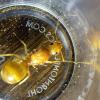Sorry this will not be as clean as the previous request, but I'm still ecstatic from the discovery, I've been circling that spot in my garden for quite some time now, and I finally made a discovery! So, I've been out to take some isopod pictures for a school project near a place where I know they have large populations, and, well, I stumbled onto some ants.
Anyway.
1. Location of collection: Unmanaged part of my garden.
2. Date of collection: 03/05/21
3. Habitat of collection: In soil under rotting wooden palettes, the soil was chock full of dead trees needles and pinecones, the ants were cohabitating with isopods, the wooden palettes were next to a singular tree..
4. Length: Exact measurements could not be taken ( I already disrupted their nest enough and didn't want to do it again to capture a worker ), the best I can provide is that they were roughly the same size as Formica rufibarbis
5. Coloration, hue, pattern and texture: Black and shiny, moderate pilosity on the thorax.
6. Distinguishing characteristics: Dunno
7. Anything else distinctive: I don't think so
8. Nest description: Very shallow earth nest right under a rotting wooden palette.
Now prepare for some incredibly blurry ant photos
Queen:
Worker 1.
Worker 2.
Worker 3.
I am sorry they are so blurry, but they were moving so fast and not stopping for even a second ( I don't blame them ), and I managed to even see the queen of the colony running away ( she was running out of the nest, so I carefully redirected her back to the ants ).
If I wanted to guess, I would say this is Camponotus vagus or Camponotus fallax, if not for the fact both are quite rare in Poland.








